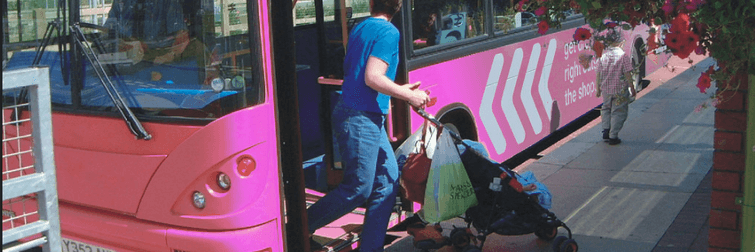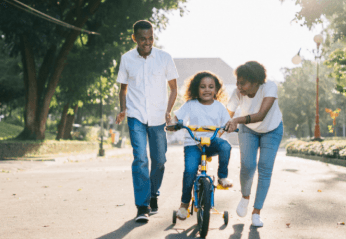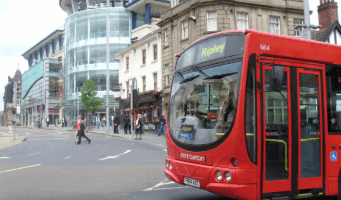
blog: The wheels on the bus go round and round…but do our kids know what a bus is?
Wednesday 4th September 2019
The School Run
With the start of the new school year fast approaching, amongst the long list of back to school jobs, my mind turns to the school run. A hectic, fume-filled environment outside the school gate with parents competing for the same car parking spaces closest to the school. Many of these children have never used a bus and would not consider walking or cycling. This led me to ask, “do the choices we make on how our children travel to school affect their travel choices in adulthood?”
I am fortunate to enjoy my walk to school with my children. However, busy lifestyles, work, and other commitments place enormous pressures on time and therefore walking or public transport is not a feasible option for many. Parents have before stated “I saw you walking this morning, I have never thought about walking.” Is this genuine? Is walking less frequently viewed as a mode of transport and does the same go for public transport? The young people of today are the future passengers of tomorrow, but do they have the correct incentives, motivation, and mindset to choose sustainable modes of travel over driving?
Travel Statistics
The Department for Transport's National Travel Survey 2018 indicates that 45% of all trips to school between the ages of 5-10 are made by car; 19% of these are for journeys which are less than a mile in distance. Trips to and from school on a local bus and walking, are at their lowest levels since 1995, whilst trips made by car are at their highest level.
Young people who do not walk or use public transport as a mode of travel before they are old enough to make their own travel choices, may be less inclined to choose this mode of transport in the future. Do parents, as role models, have the power to change the mindset of travel behaviour for today’s young people? Is it the parents’ perception that using the bus isn’t as safe as driving; a factor that deprives our children of the skills required to make informed travel choices, and the confidence to use public transport independently?
Parents' Perceptions
According to the travel to school factsheet from the National Travel Survey, the main reasons for accompanying children to school are traffic, danger, fear of assault, and fear of bullying, which are all due to parental perceptions of safety. These are often passed on to children without realising. Allowing a young person to plan their own route using public transport carries a whole host of perceived dangers, not only using the bus, but road safety concerns about the walk to the bus stop, especially if the child or parent themselves has no previous experience of travelling in this way.
What Do the Scandanavians Do Differently?
There is a great deal of literature on modal choice in Scandinavian countries and how sustainable travel plays a huge role in day-to-day journeys. With resilience being the new buzzword in the parenting world, it leads me to think about how different cultures nurture resilience and whether this also impacts travel choices.
In Denmark, parents tend not to intervene unless absolutely necessary, giving children encouragement but also space to build their own trust in themselves, providing support when needed, but then inviting them to go further and develop and master new skills. This in turn builds their confidence and independence.
“Resilience isn’t cultivated by avoiding stress you see, but by learning how to tame and master it.”
Inspired by the freedom young children have in other countries, the documentary Planet Child looked at whether modern British children are still developing the skills they need to be independent. The natural instinct of a parent is to protect their children, however, watching the confidence of a child navigating their own way to the London Eye on a bus is captivating, with their biggest challenge of identifying the correct time to get off the bus. Given the responsibility and freedom they managed to successfully leave the bus, completing the task better than expected, at the correct location with a huge sense of achievement. Following the show, one of the doctors working on the set was asked whether the show had changed his views on parenting and his response was:
“My daughter is almost two and I’m careful to stand back while she falls off things – nothing dangerous – so she’ll get a bump and learn how to not fall.”

This appears to be a key component of Danish parenting and is in fact an important facilitator to independence, learning to pick yourself up when you fall and not just avoid situations which you are uncertain about. Government support in Denmark, providing suitable investment to develop an efficient and integrated transport system, is a huge factor influencing its modal share, providing confidence, safety, and ease in sustainable modal choice.
Research undertaken for Transport Focus indicated that for young people, embarrassment is a barrier to using the bus; this, coupled with the fear of the unknown, can make public transport seem quite daunting. Common concerns are identifying the correct stop, communicating with the bus driver, and having the correct change for the journey.

But the benefits of sustainable travel (exercise, environmental impact, connecting with people, ‘seeing the world’, independence, mental health) are so important. So, how do we encourage the children of today to travel sustainably in the future? Letting go and supporting children in being more independent like our Scandinavian cousins is one way. Education is certainly another. But it is also important to have a transport system which is integrated, safe, easy to use, and has good information. And that is where we as transport planners come in. Effective planning, information, ticketing, and developing innovative solutions, are all important in achieving this and what we at ITP are passionate about.
If you would like to learn more about what we do in the Public Transport Team, click here or get in touch.
